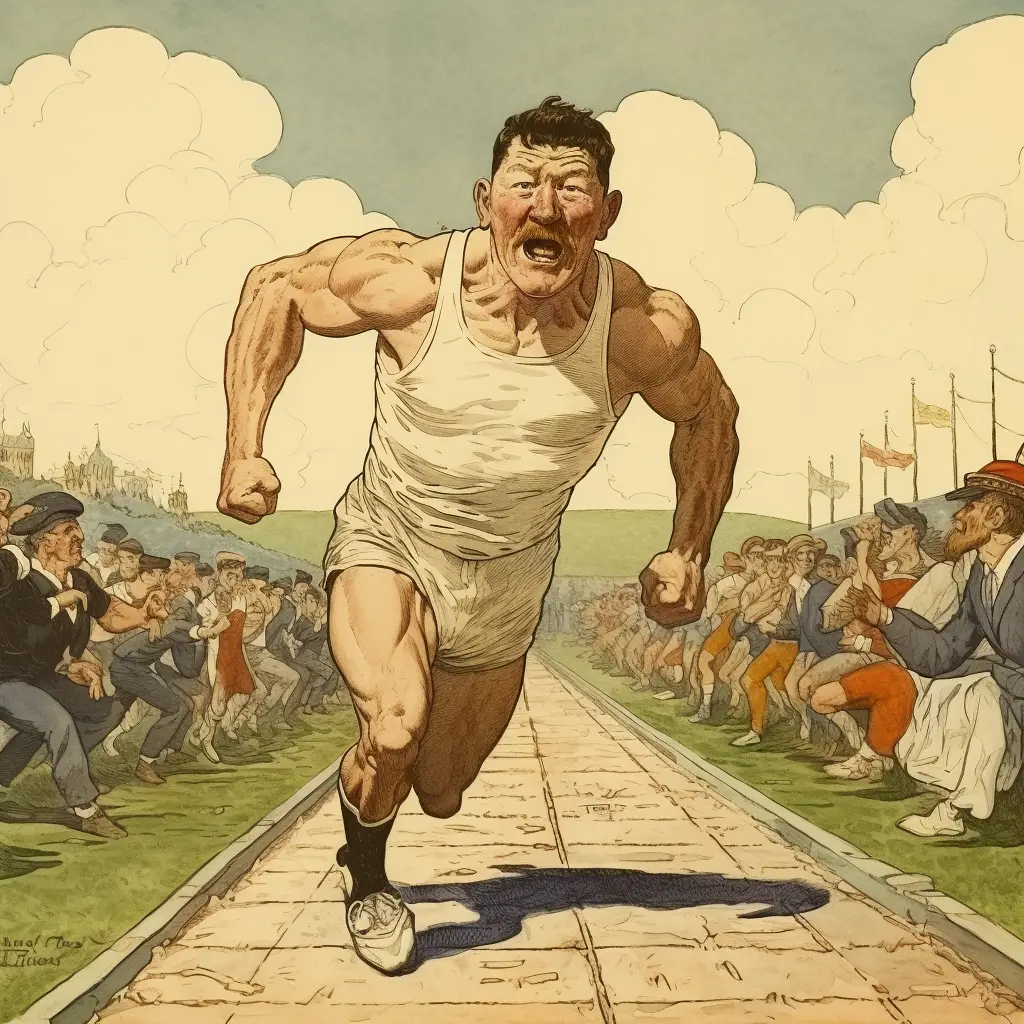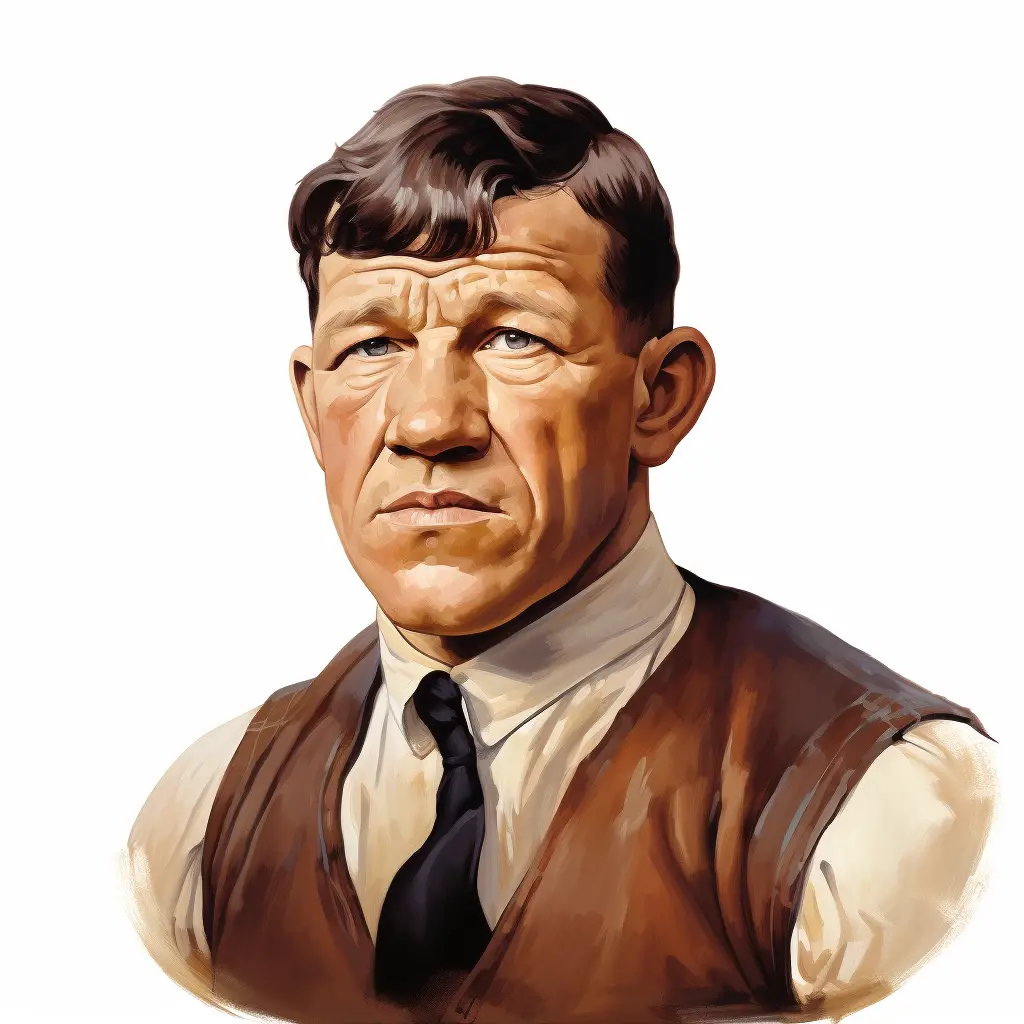Jim Thorpe
Jim Thorpe was a Native American athlete who excelled in multiple sports, including football, baseball, and track and field. He won two gold medals in the 1912 Olympics and was considered one of the greatest athletes of his time. Despite facing discrimination and adversity, Thorpe’s talent and determination allowed him to achieve remarkable success in his athletic career. His legacy continues to inspire and serve as a testament to the power of perseverance and skill.
Jim Thorpe Facts For Kids
- Jim Thorpe was a Native American athlete.
- He was born on May 28, 1887.
- Thorpe played both football and baseball professionally.
- He won gold medals at the 1912 Olympics.
- Thorpe was stripped of his Olympic medals unfairly.
- The medals were returned to him posthumously in 1983.
- He was the first president of the NFL.
- Thorpe played for the Canton Bulldogs football team.
- He was named “Greatest Athlete” by ABC’s Wide World of Sports.
- Jim Thorpe passed away on March 28, 1953.
Olympics and athletic competitions
Recognized as one of the greatest all-around athletes in history, Jim Thorpe made a significant contribution to the sports world through his exceptional athletic ability and dedication. He achieved fame and acclaim in the 1912 Olympics, where he won two gold medals in the pentathlon and decathlon, cementing his status as an incredibly talented athlete.
Beyond his track and field accomplishments, Thorpe also demonstrated his versatility by playing professional baseball and football. His success across multiple sports disciplines serves as a powerful source of inspiration for young athletes to pursue and excel in diverse sports competitions.
Native American athletes
Jim Thorpe, a resilient and determined athlete from the Sac and Fox nation, demonstrated the power of individual potential, regardless of one’s background. Known by his native name, Wa-Tho-Huk, meaning ‘Bright Path’, Thorpe indeed illuminated a successful trajectory amidst numerous challenges.
His extraordinary talents in sports made him a superstar in the early 20th century, with his crowning achievements being the two gold medals he won in the 1912 Olympics for pentathlon and decathlon. These victories underscored his exceptional versatility in sports, spanning professional baseball, basketball, and football.
Thorpe’s remarkable accomplishments continue to inspire Native American athletes, evidencing that great potential can be realized irrespective of its origins.
Pro Football Hall of Fame
Recognized as one of the most outstanding athletes of his era, Jim Thorpe holds a prominent place in the realm of American Football. In homage to his remarkable skills and substantial contribution to the sport, he was among the first individuals to be inducted into the Pro Football Hall of Fame in 1963.
Thorpe’s exceptional versatility saw him shine in numerous positions on the field, such as halfback, placekicker, and punter. His stellar accomplishments and extraordinary abilities remain a source of inspiration for budding football aficionados today.
Early 20th-century American sports
Jim Thorpe, an extraordinary athlete originating from the Sac and Fox Nation in Oklahoma in 1887, had a profound influence on early 20th-century American sports with his exceptional skills in football, baseball, and track and field.
Internationally acclaimed for his dual gold medal victory in the 1912 Olympics’ pentathlon and decathlon, Thorpe was a true embodiment of versatility, juggling professional careers in both football and baseball. Despite the racial discrimination he faced, his robust talent and unwavering determination enabled him to shatter barriers, making him a pioneering figure in American sports history.
The town of Jim Thorpe, Pennsylvania
Named after the legendary athlete Jim Thorpe, recognized as one of the greatest athletes of the 20th century, the small and charming town of Jim Thorpe, Pennsylvania, carries a legacy of rich history and beautiful scenery.
Despite the fact that Jim Thorpe wasn’t born or raised there, the town is imbued with his spirit, taking immense pride in bearing his name and continuously celebrating his life and accomplishments. This makes it an ideal location for learning about this extraordinary athlete and his significant impact on sports history.
Decathlon and pentathlon

Recognized as an extraordinary all-around athlete, Jim Thorpe gained fame for his impressive accomplishments in the challenging Decathlon and Pentathlon events at the 1912 Olympics. The complexity of these events, which test an athlete’s prowess in a variety of sports such as running, jumping, and throwing, underscores Thorpe’s exceptional skill in more than just one sport.
His remarkable ability to excel across multiple sports earned him gold medals in both the Decathlon and Pentathlon, establishing him as one of the world’s most versatile athletes. Thorpe’s accomplishments have since served as an inspiration for aspiring athletes worldwide, making him a cherished role model.
Carlisle Indian Industrial School
In the early 20th century, Jim Thorpe, a Native American athlete, honed his exceptional skills in sports, particularly football and track, and field, at the Carlisle Indian Industrial School in Pennsylvania. This institution was designed as a conduit for Native American children to acquire new skills and assimilate into mainstream American culture.
Despite the challenges presented by life at the school, it served as the crucible where Thorpe’s unique athletic talents were identified and cultivated, ultimately catapulting him to the status of one of the most outstanding athletes of the 20th century.
Track and field history
Born in 1888 as a Native American from the Sac and Fox Nation, Jim Thorpe overcame numerous challenges to make a significant mark on the history of track and field. As an exceptional athlete, he stood out in the 1912 Olympics, where his unparalleled performance in the pentathlon and decathlon events won him two gold medals.
This legendary feat made him the first and only person to accomplish such a victory, earning him the title ‘the greatest athlete in the world.’ Thorpe’s remarkable track and field legacy is a testament to his relentless perseverance, immense talent, and unwavering dedication.
Early NFL and Major League Baseball
Jim Thorpe, a legendary figure in American sports history, was renowned for his extraordinary athletic prowess in the formative years of the National Football League (NFL) and Major League Baseball (MLB). His exceptional skills, including his speed, agility, and strength, not only earned him a superstar status in the NFL but also led to him becoming the league’s inaugural president in 1920.
Throughout his football journey, he showcased his versatility by playing for six NFL teams in multiple positions. However, Thorpe’s athletic brilliance wasn’t confined to football alone. He also graced the baseball field for six seasons, mostly as an outfielder for the New York Giants in the MLB.
Despite the lack of recognition for athletes during his time, Thorpe’s impressive versatility and remarkable talent in both football and baseball solidified his status as a pioneering icon in the realm of American sports.
Sports and racial barriers
Jim Thorpe, a member of the Sac and Fox Nation, was an outstandingly gifted athlete who excelled in sports such as football, baseball, and track and field, breaking numerous records in the early 20th century.
His achievements are particularly noteworthy considering he was a Native American at a time when racial discrimination was prevalent in the United States. Thorpe’s extraordinary success in sports defied and dismantled many racial barriers, demonstrating that talent and perseverance could surmount prejudice and stereotyping.
His uplifting narrative serves as a profound testament to the capacity of sports to foster equality and challenge societal prejudices.
Jim Thorpe: The Bright Path to Athletic Greatness
Jim Thorpe was born in 1888 in Oklahoma, on Sac-and-Fox Indian land. His given name was Wa-Tho-Huk, which meant “bright path.” His start as an athlete began in the schoolyards of his childhood. He often ran the twenty miles from school back to his home.
While attending the Carlisle Indian School in Pennsylvania, Thorpe happened to pass some students who were practicing track. Time and again, he watched as students failed to make the high jump. Even though he was dressed in overalls, Thorpe gave it a shot, and cleared the bar!
Olympic Triumph and Amateur Status Controversy
In 1912, Thorpe competed in the Stockholm Olympics, where he won medals He won the pentathlon, came in seventh in the long jump, and set a world record in the decathlon. He met the king of Sweden, who told him he was the greatest athlete in the world. He returned to the United States and was greeted with a ticker-tape parade in New York City.
Unfortunately for Thorpe, in the summers before he participated in the Olympics, he was paid to play baseball. Many amateur athletes were paid, but most used fake names to get around the rules. Thorpe used his real name. He was paid very little—just two dollars a game. However, Olympic rules stated that an athlete who was paid was not an amateur, and amateurs were not permitted to compete in the games.
Triumphs, Struggles, and Olympic Redemption
In 1912, a reporter discovered that Thorpe had been paid to play baseball. Thorpe claimed he had not known of the rules (which might explain why he—unlike other athletes—had used his real name). He said, “I hope I will be partly excused by the fact that I was simply an Indian schoolboy and did not know all about such things. I was not very wise in the ways of the world and did not realize this was wrong.” In early 1913, Thorpe’s Olympic medals were taken from him.
Thorpe eventually signed with the New York Giants and eventually played with the Cincinnati Reds and Boston Braves. He also played football for the NFL and served as the first president of the American Professional Football Association.
After leaving sports, Thorpe held a variety of jobs, including working as an extra in Hollywood films. He often struggled to earn enough money to provide for his family. In 1982, the International Olympic Committee restored Thorpe’s gold medals, roughly thirty years after his death.
Facts About Jim Thorpe:
- A town in Pennsylvania changed its name to Jim Thorpe
- Burt Lancaster portrayed Thorpe in a movie, “Jim Thorpe, All-American”
- Thorpe was buried in Pennsylvania, but his grave included mounds of soil from Oklahoma as well as the Olympic stadium in Stockholm, Sweden




